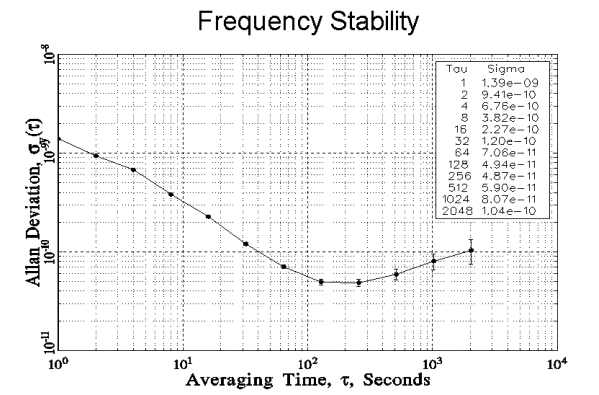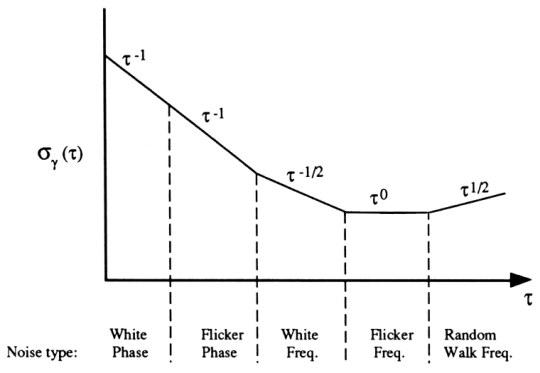|
|
|
|
|
Time and Frequency from A to Z: A to Al
|
|
|
|
|
| A-Al | Am-B | C-Ce | Ch-Cy | D-Do | Dr-E | F | G | H | I | J-K | L | M |
| N-O | P | Q-Ra | Re-Ru | S-So | St-Sy | T-Te | Ti | To-Tw | U-W | X-Z | Notes | Index |
A440
A440 (sometimes called A4) is the 440 Hz tone that serves as the internationally recognized standard for musical pitch. A440 is the musical note A above middle C. Since 1939, it has served as the audio frequency reference for the calibration of pianos, violins, and other musical instruments.
Tuning a piano is an example of a simple frequency calibration that is actually done with the human ear. The piano tuner listens to a standard musical pitch and compares it to the same note on the piano keyboard. The piano is then adjusted (by tightening or loosening strings), until it agrees with the audio standard. What is the smallest frequency offset that a piano tuner can hear? It depends on lots of factors, including the sound volume, the duration of the tone, the suddenness of the frequency change, and the musical training of the listener. However, the just noticeable difference is often defined as 5 cents, where 1 cent is 1/100 of the ratio between two adjacent tones on the piano’s keyboard. Since there are 12 tones in a piano’s octave, the ratio for a frequency change of 1 cent is the 1200th root of 2. Therefore, to raise a musical pitch by 1 cent, you would multiply by the 1200th root of 2, or 1.000577790. If you do this 5 times starting with 440 Hz, you’ll see that 5 cents high is about 441.3 Hz, or high in frequency by 1.3 Hz.
NIST (then called the National Bureau of Standards) began broadcasting A440 from radio station WWV in 1936, several years before A440 was officially recognized as an audio frequency standard. The tones can currently be heard during minute 2 of each hour on WWV, and during minute 1 on WWVH. The 440 Hz tone is omitted, however, during the first hour of each UTC day.
Accuracy is the degree of conformity of a measured or calculated value to its definition. Accuracy is related to the offset from an ideal value. In the world of time and frequency, accuracy is used to refer to the time offset or frequency offset of a device. For example, time offset is the difference between a measured on-time pulse and an ideal on-time pulse that coincides exactly with UTC. Frequency offset is the difference between a measured frequency and an ideal frequency with zero uncertainty. This ideal frequency is called the nominal frequency. The relationship between accuracy and stability is illustrated below.

In recent years, the term uncertainty has been given preference over accuracy when a quantitative measure is stated. Accuracy is often used in a qualitative sense. For example, we might say that a time measurement has an uncertainty of 1 microsecond, and that the accuracy of the measurement is very good.
An atomic oscillator, usually a hydrogen maser, whose output signal is derived from the radiation emitted by the atom. Most commercially available atomic oscillators are passive frequency standards.
A change in frequency with time due to internal changes in an oscillator. Aging is usually a nearly linear change in the resonance frequency that can be either positive or negative, and occasionally, a reversal in direction of aging occurs. Aging occurs even when factors external to the oscillator, such as environment and power supply, are kept constant. Aging has many possible causes, including a buildup of foreign material on the crystal, changes in the oscillator circuitry, or changes in the quartz material or crystal structure. A high quality OCXO might age at a rate of < 5 x 10-9 per year, while a TCXO might age 100 times faster.
A non-classical statistic used to estimate stability. This statistic is sometimes called the Allan variance, but since it is the square root of the variance, its proper name is the Allan deviation. The equation for the Allan deviation is

where  seconds long. Or
seconds long. Or

where xi is a series of phase measurements in time units that consists of individual measurements, x1, x2, x3, and so on, N is the number of values in the xi series, and the data are equally spaced in segments  seconds long.
seconds long.
A graph of Allan deviation is shown below. It shows the stability of the device improving as the averaging period ( ) gets longer, since some noise types can be removed by averaging. At some point, however, more averaging no longer improves the results. This point is called the noise floor, or the point where the remaining noise consists of nonstationary processes such as aging or random walk. The device in the graph has a noise floor of about 5 x 10-11 at
) gets longer, since some noise types can be removed by averaging. At some point, however, more averaging no longer improves the results. This point is called the noise floor, or the point where the remaining noise consists of nonstationary processes such as aging or random walk. The device in the graph has a noise floor of about 5 x 10-11 at  = 100 s.
= 100 s.

The Allan deviation is also used to identify types of oscillator and measurement system noise. The slope of the Allan deviation line can identify the amount of averaging needed to remove these noise types, as shown in the graph below. Note that the Allan deviation does not distinguish between white phase noise and flicker phase noise.

| A-Al | Am-B | C-Ce | Ch-Cy | D-Do | Dr-E | F | G | H | I | J-K | L | M |
| N-O | P | Q-Ra | Re-Ru | S-So | St-Sy | T-Te | Ti | To-Tw | U-W | X-Z | Notes | Index |
